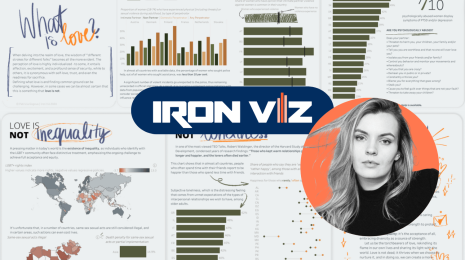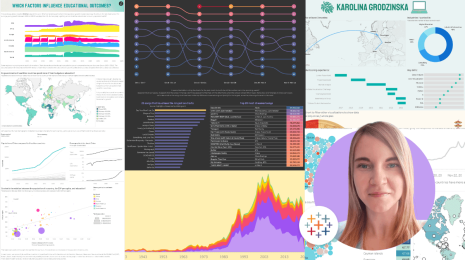Black History Month Celebrated: Visualize Diversity
Chantilly Jaggernauth is a senior data analyst at Comcast, a telecommunications conglomerate based in Philadelphia, Pennsylvania. In this post, Chantilly shares how Black History Month can be celebrated through data visualization.
Did you know Black History Month was originally not a month at all? The inception of celebrating African Americans was curated as a week to be honored during the second week of February. In 1926, Dr. Carter G. Woodson, an African-American historian, educator and NAACP leader, was the first to announce the creation of Negro History Week. His goal was to encourage the teachings of African American history in the nation’s public schools. In 1976, during the United States Bicentennial, President Gerald Ford officially recognized Black History Month and urged Americans to “seize the opportunity to honor the too-often neglected accomplishments of black Americans in every area of endeavor throughout our history.”
From slavery to the first African American President of the United States, African American influence is woven into the narrative of our history. Celebrating the accomplishments and stories of individuals before us provides a measurable marker of where we were, where we are and where we can be. As February begins, let’s reflect upon the impact that black history has made among the collective consciousness of this diverse nation.
During the Paris World Fair of 1900, W.E.B. Du Bois, Booker T. Washington and Thomas J. Calloway presented an exhibition on the state of African American life titled, “The Exhibit of American Negros.” The exhibition was groundbreaking as it visually displayed statistics of the life and post-slavery progression of African-Americans in the U.S. The exhibit featured photographs, 350 patents awarded to African American inventors, 200 books written by African American authors, and more than 60 hand-drawn, full-colored charts created by Du Bois and his students. Through the use of data and data visualizations, W.E.B. Du Bois highlighted, celebrated, and informed people globally on how far the African American community had advanced over the century.
Just like Du Bois, we want to highlight and celebrate the accomplishments of African Americans throughout February and more specifically with the Tableau community. To do so, we will share awe-inspiring, community projects, in which anyone can participate. Here’s an outline of them, where to get information, and how to participate.
Week 1: Makeover Monday
Makeover Monday is a weekly social data project, and this week focused on sports. The project is available in the Makeover Monday project hosted on Data.World, ready for you to analyze and visualize. Here’s how to participate:
- Publish your viz to Tableau Public.
- Share on Twitter. Be sure to include an image of your viz, tag @VizWizBI and @TriMyData, and use #MakeoverMonday and #VisualizeDiversity.
- Share on data.world. Share your viz in the discussion tab of the Makeover Monday dataset on data.world.
If you want feedback on your viz, post it in the Viz Review Discussion tab of the dataset. Makeover Monday Viz Review is a live webinar, during which Eva Murray and Andy Kriebel will provide community feedback on the visualizations. The webinar is usually 75 minutes long, but can extend to 90 minutes, allowing an extra five to seven vizzes to be reviewed. You can watch a recording of this webinar on BrightTalk.
Click here to see a roundup of the vizzes from week 1.
For more about week one, visit the data.world week 1 project.
Week 2: Storytelling with Data
Launched by Cole Nussbaumer Knaflic in 2018, the #SWDchallenge is a safe space to hone your data visualization and data storytelling skills. This particular challenge focused on education, and more details on the topic can be found on the Storytelling with Data blog. Here’s how to participate:
- Publish your viz to Tableau Public
- Submit by email. Email your entry to SWDchallenge@storytellingwithdata.com. Attach your image as a .PNG. Put any commentary you’d like included in the follow-up post in the body of the email. If there’s a social media profile or blog/site you want mentioned, please embed the links directly in your commentary. The deadline to submit is Tuesday, 2/13 (by midnight PST).
- Share on Twitter. Tweet a link to the viz with the hashtags #SWDChallenge and #VisualizeDiversity to submit your visualizations.
- Share on data.world. Share your viz in the insights tab of the data.world week 2 project.
Click here to see a roundup of the vizzes from week 2.
Week 3: Viz for Social Good
Led by Chloe Tseng, Viz for Social Good empowers nonprofits through data storytelling. During the third week of February, Viz For Social Good will focus on women in politics. Data and more information is now available on the Viz for Social Good website. Here’s how to participate:
- Become a volunteer. Viz for Social Good volunteers will receive an email notification about the new project. You can sign up here.
- Publish your viz to Tableau Public.
- Share on Twitter. Tweet a link and an image of your viz, mention @DataChloe and @PollicyOrg, and use the hashtags #VizforSocialGood and #VisualizeDiversity.
- Share on data.world. Share your viz in the insights tab of the data.world week 3 project.
Participants can join Viz for Social Good Slack channel #Pollicy to discuss their findings or ask questions.
Week 4: Data for Democracy
Data for Democracy is an inclusive community for data scientists and technologists to volunteer and collaborate on projects that positively impact society. The topic for the last week of February will be civic engagement and politics. Here’s how to participate:
- Publish your viz to Tableau Public.
- Share on data.world. Share your viz in the insights tab of the data.world week 4 project.
Here are a couple data sets that might help you get started, but this data only scratches the surface of civic engagement and politics. Have a different data set in mind? Add to the discussion tab on data.world.
- U.S. Naturalizations sourced from U.S. Department of Homeland Security
- Notable U.S. Immigrants sourced from Wikipedia
Black History Month originated to enlighten everyone on the culture, history and accomplishments of African Americans. As we’ve seen in history and in our own endeavors, this can be accomplished leveraging data and data visualizations. We encourage anyone to participate and help us inform, highlight and celebrate the African American community during February.
関連ストーリー
Subscribe to our blog
Tableau の最新情報をメールでお知らせします







